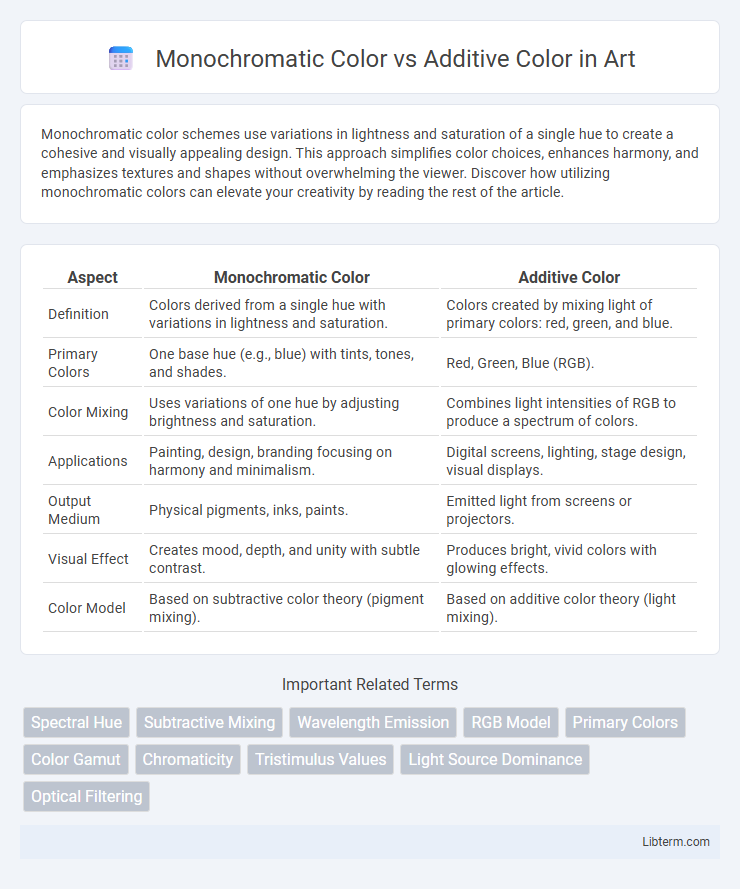Monochromatic color schemes use variations in lightness and saturation of a single hue to create a cohesive and visually appealing design. This approach simplifies color choices, enhances harmony, and emphasizes textures and shapes without overwhelming the viewer. Discover how utilizing monochromatic colors can elevate your creativity by reading the rest of the article.
Table of Comparison
| Aspect | Monochromatic Color | Additive Color |
|---|---|---|
| Definition | Colors derived from a single hue with variations in lightness and saturation. | Colors created by mixing light of primary colors: red, green, and blue. |
| Primary Colors | One base hue (e.g., blue) with tints, tones, and shades. | Red, Green, Blue (RGB). |
| Color Mixing | Uses variations of one hue by adjusting brightness and saturation. | Combines light intensities of RGB to produce a spectrum of colors. |
| Applications | Painting, design, branding focusing on harmony and minimalism. | Digital screens, lighting, stage design, visual displays. |
| Output Medium | Physical pigments, inks, paints. | Emitted light from screens or projectors. |
| Visual Effect | Creates mood, depth, and unity with subtle contrast. | Produces bright, vivid colors with glowing effects. |
| Color Model | Based on subtractive color theory (pigment mixing). | Based on additive color theory (light mixing). |
Understanding Monochromatic Color
Monochromatic color refers to variations of a single hue achieved by altering its saturation and brightness, creating a cohesive and harmonious visual effect. This color scheme relies on one base color combined with its tints, tones, and shades, offering a unified and aesthetically pleasing design. Understanding monochromatic color enhances color theory applications in art, design, and digital media by emphasizing simplicity and balance within a single hue spectrum.
The Basics of Additive Color
Additive color theory involves combining red, green, and blue light to create a wide spectrum of colors, with white produced by mixing all three at full intensity. This color model is fundamental in digital screens and lighting, where light sources overlap to generate various hues. Understanding additive color principles is essential for technologies like TVs, computer monitors, and stage lighting systems.
Key Differences Between Monochromatic and Additive Color
Monochromatic color involves varying shades, tints, and tones of a single hue, emphasizing uniformity and harmony within a single color spectrum. Additive color combines red, green, and blue light to create a wide range of colors through light blending, primarily used in digital screens and displays. The key difference lies in monochromatic relying on a single base color with variations, while additive color produces diverse colors by mixing multiple light wavelengths.
Color Theory Fundamentals
Monochromatic color schemes are derived from a single hue by varying its saturation and brightness, emphasizing harmony and visual cohesion in design. Additive color theory involves combining red, green, and blue light to create various colors, with the mixture of all three yielding white light. Understanding the distinction between subtractive (monochromatic) and additive color models is fundamental for applications in digital displays and traditional art.
Visual Effects in Monochromatic Schemes
Monochromatic color schemes create visual effects by using variations in lightness and saturation of a single hue, producing a harmonious and soothing design that reduces visual clutter. In contrast to additive color models that mix red, green, and blue to create vibrant and dynamic images, monochromatic schemes emphasize depth and texture through subtle tonal shifts. This approach enhances focus and mood, often used in minimalist art and design to evoke emotion without overwhelming the viewer.
Mixing Light: The Additive Process
Mixing light in the additive process involves combining different wavelengths of light to create new colors, primarily using red, green, and blue (RGB) as primary colors. Monochromatic color refers to light of a single wavelength, producing pure hues without mixing, whereas additive color mixing blends multiple monochromatic lights to generate a broad color spectrum. This process is fundamental in technologies like digital displays and stage lighting, where precise control over light intensity and color composition enables vivid and dynamic visual effects.
Applications in Art and Design
Monochromatic color schemes emphasize variations of a single hue, often used in art and design to create cohesive, harmonious compositions that evoke specific moods or emotions. Additive color, combining red, green, and blue light, is essential in digital media and screen-based design, enabling vibrant, dynamic visuals through color mixing. Artists and designers leverage monochromatic palettes for subtlety and depth, while additive color systems are pivotal in interactive and multimedia applications requiring precise color control.
Psychological Impact of Color Methods
Monochromatic color schemes, using variations in lightness and saturation of a single hue, evoke feelings of harmony and calmness by minimizing visual complexity and creating a cohesive emotional response. Additive color methods, combining red, green, and blue light to produce vibrant and dynamic hues, stimulate visual excitement and increased attention, often associated with digital screens and modern interfaces. Understanding these psychological impacts helps designers manipulate mood and focus through color methodology selection in visual communication.
Monochromatic vs Additive in Digital Media
Monochromatic color in digital media involves using various shades, tints, and tones of a single hue to create a cohesive and harmonious visual effect. Additive color refers to the process of combining red, green, and blue light (RGB) to produce a wide spectrum of colors on digital screens, where increasing light intensity adds to the overall brightness. Understanding the contrast between monochromatic schemes and additive color mixing is essential for effective digital design, as it influences color harmony, contrast, and user experience.
Choosing the Right Color Approach
Choosing the right color approach depends on the desired visual effect and application: monochromatic color schemes emphasize variations of a single hue for harmonious, subtle designs, ideal for branding and minimalist art. Additive color mixing, using combinations of red, green, and blue light to create a wide spectrum, is essential for digital displays and lighting where vibrant, dynamic color reproduction is required. Understanding the context and medium ensures optimal color impact and viewer experience.
Monochromatic Color Infographic

 libterm.com
libterm.com